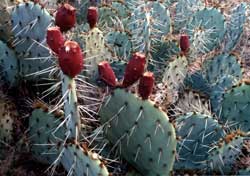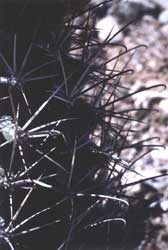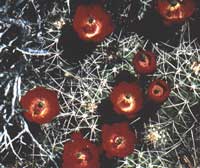|
 It is a classic cartoon. The one where the lost hiker crawls
across the barren desert while a relentless sun beats down
on the unfortunate soul. The desperate individual reaches
a tall cactus growing out of a bed of sand and then he gouges
the stem and drinks the life-saving fountain of water. Graphic,
but wrong.
It is a classic cartoon. The one where the lost hiker crawls
across the barren desert while a relentless sun beats down
on the unfortunate soul. The desperate individual reaches
a tall cactus growing out of a bed of sand and then he gouges
the stem and drinks the life-saving fountain of water. Graphic,
but wrong.
 Cacti
are not kegs of water. They are not “fixed hydration
units.” You cannot puncture one and expect, like a Maytag™
refrigerator, for cold water and crushed ice to come tumbling
down into a mug. Doesn’t happen. Cacti
are not kegs of water. They are not “fixed hydration
units.” You cannot puncture one and expect, like a Maytag™
refrigerator, for cold water and crushed ice to come tumbling
down into a mug. Doesn’t happen.
Cactus cells do have the capacity to swell when excessive
moisture is present in the soil. Extensive root systems that
resemble a Los Angeles freeway spread throughout the soil,
penetrating and absorbing this precious commodity. As the
cactus increases its absorption of moisture, the cells swell
like water balloons. But the moisture is transformed into
cytoplasm, not stored as H2O.
Of the three types of cacti that grow in Canyon Country, prickly
pears are the most conspicuous. Members of the Opuntia genus,
these prickly pears have flattened pads that are jointed together
connected like  Legos™.
The pads have both long and short spines that arise from a
common point, and like one individual, whose species name
polyacantha means “many spines,” these plants may
be densely covered with mouth-infecting spines. The spines
are not toxic, but an unwitting herbivore will surely develop
mouth sores due to festering spines. Legos™.
The pads have both long and short spines that arise from a
common point, and like one individual, whose species name
polyacantha means “many spines,” these plants may
be densely covered with mouth-infecting spines. The spines
are not toxic, but an unwitting herbivore will surely develop
mouth sores due to festering spines.
Flowering in May and June, these colorful flowers attract
a myriad of flying pollinators. A quick glance down into the
waving sea of stamens will often reveal several different
types of beetles or bees all working quickly to collect the
abundant pollen. The insects move about like someone trying
to escape from a dense closet of clothes - they push their
way through the racks of stamens. Post-pollination, the flowers
fade and are replaced by thumb-sized fruits called tunas.
When mature, the fruits are red and filled with many seeds.
The sweet pulp is a prize, well worth the suffering inflicted
by the numerous tiny spines that embed in your skin. Gloves
are recommended when harvesting these fruits, and often the
speared fruits are rotated over a hot flame to burn off these
offensive spines.
 Named
for its fishhook-shaped spines, another desert cactus, the
Whipple’s fishhook (Sclerocactus whipplei), honors Amiel
Wicks Whipple (1818-1863), a topographical engineer who served
on a boundary survey between the United States and Mexico
in 1853-1856, and who passed away in May of 1863 during the
Civil War. Lavender purple flowers sprout from the top of
this small barrel cactus that reminds me of a pineapple. Though
the floral colors may vary from pink to white or even yellow
their delicacy defines them. Named
for its fishhook-shaped spines, another desert cactus, the
Whipple’s fishhook (Sclerocactus whipplei), honors Amiel
Wicks Whipple (1818-1863), a topographical engineer who served
on a boundary survey between the United States and Mexico
in 1853-1856, and who passed away in May of 1863 during the
Civil War. Lavender purple flowers sprout from the top of
this small barrel cactus that reminds me of a pineapple. Though
the floral colors may vary from pink to white or even yellow
their delicacy defines them.
 The
third type of cactus found in Canyon Country is the hedgehog
(Echinocereus triglochidatus). Try saying that three times
fast. Echinocereus is from the Greek words echinos (hedgehog),
referring to the resemblance of this plant to the spiny mammal.
Triglochidiatus means “three-straight-spines” a
reference to the orderly arrangement of the spines. Another
barrel cactus like the fishhook, the hedgehog tends to grow
in clusters, from a few to several hundred stems in a tight
hemispherical clump. The brilliant red flowers are the color
of a dance-hall girl’s lips, and they seem to erupt from
the plant, frozen in mid-pucker. Like some lonesome cowboy,
hummingbirds are attracted to these flowers for the promise
of sweetness. The
third type of cactus found in Canyon Country is the hedgehog
(Echinocereus triglochidatus). Try saying that three times
fast. Echinocereus is from the Greek words echinos (hedgehog),
referring to the resemblance of this plant to the spiny mammal.
Triglochidiatus means “three-straight-spines” a
reference to the orderly arrangement of the spines. Another
barrel cactus like the fishhook, the hedgehog tends to grow
in clusters, from a few to several hundred stems in a tight
hemispherical clump. The brilliant red flowers are the color
of a dance-hall girl’s lips, and they seem to erupt from
the plant, frozen in mid-pucker. Like some lonesome cowboy,
hummingbirds are attracted to these flowers for the promise
of sweetness.
Like many desert plants, the cacti often go unnoticed during
most of the year. However, when May arrives and summer is
just a blossom away, these plants unfurl their flowers in
a brilliant display of floral fashion. So watch for their
floral shows and watch out for those spines!
|